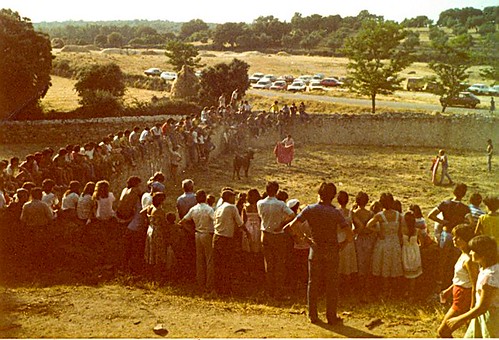
Before the current name since the Middle Ages, the town was called Arriba Almendral Almendral and late nineteenth century. Since 1916 was renamed Almendral de la Cañada Cañada because Real is going through its southern part.
Due to traffic situation and the mild climate of the Shire, Shire civilizations chose to set his dwelling, which is evidenced by various remains have been found. This applies to the megalithic monuments in prehistoric times, as are «Majano», and some rock tombs of the Middle Ages, known as the «arts» among.
Holidays
May 15: San Isidro.
September 8: Our Lady of Antigua.
September 11: Blessed Ana
17 and 18 December: Living Representation of Bethlehem.
In almost all festivals celebrated in the region, visitors are invited to something to eat and drink to enjoy even more of the uniqueness of these festivities.
Location:
Municipality located in the foothills of the Sierra de San Vicente in the north of the region, the slope of the peak in Las Cruces. The best way to get there is through the N-501 (Madrid-Plasencia) turn onto the CM-5053, and through the direction Iglesuela Navamorcuende take the CM-5051 to this town.
Also accessible by bus.
How to visit?
Church of Our Lady of La Antigua (Monument included in the Heritage Inventory of Regional Interest of the Province of Toledo) The s. XIX. Standing on a century old chapel XV. Building a nave with a semicircular apse. Chapel separated from the nave by a semicircular triumphal arch.
Church of San Salvador: (Monument included in the Heritage Inventory of Regional Interest of the Province of Toledo) The s. XIII reforms to s. XVIII. Old church is now part of the cemetery. Remains at the top of the tower, a small Gothic chapel turned into a cemetery.
Ermita de San Sebastian: the end of s. XVIII. Constructed in blocks at corners and jambs, square and hipped roof. It is much restored.

Ermita Cristo de la Sangre: s. XVIII. Small square chapel restored. In the interior retains a small altar and a niche that houses the image of Christ.
Miller mills: three mills, one cube on Torinos Throat, another ramp on the Arroyo de la Fuente and the third large bucket on the Arroyo del Lugar with a pre-seventeenth century old.
The Tejea Mill (on the border with El Real de San Vicente) has its own prey.
Source-Manger of La Cañada (Monument included in the Heritage Inventory of Regional Interest of the Province of Toledo): s. XVIII-XIX (1857). Source trough, whose basin is formed by large stones in one piece from the ground. His condition is very good. The cross supports on the front is a later period.
Other Sources: There are a group of sources of interest: «Well Prado» of medieval times, inside the town, near the monument to the Blessed Ana, another source is located medieval brought from the canyon real along the glen there are sources of concern «Cano de la República», the source of Canillo, the source of Canada, if you search on some of these sources can be found cruciform signs.
Stone Zoo: Located on a farm near the Arroyo Place, near the end of the Iglesuela, is an interesting open air museum of folk sculpture. D. Longino Ayuso, rancher from La Iglesuela, while tending to his cattle carved in the granite boulders, he saw figures inside, huge sculptures with animal motifs. Situated on a private farm, but can be accessed without problems.
Curiosities:
In the bar the retiree is the world’s largest zambomba. It was registered in the Guinness Book of Records in 1999. Blessed Anne of St. Bartholomew, secretary of Santa Teresa de Jesus was born in 1549 in this town. His house, tradition says, was near the present church. It was broadcaster and founder of the Carmelite convents in France and the Netherlands in the s. XVI.

Welcome to Almendral de la Cañada in Toledo!
Leave a Reply
You must be logged in to post a comment.
Recent Comments